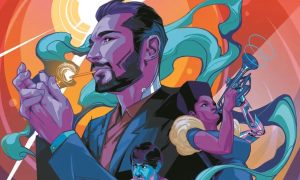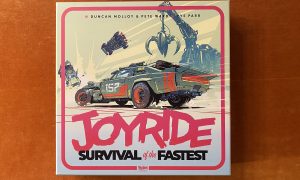inFAMOUS: Second Son will probably be remembered more for its depiction of Seattle than anything else.
It’s not that Second Son is a bad game — in fact, it’s the best realization of the inFAMOUS series to date. But the next generation of consoles bring with them the promise of evolution, the potential of something far greater than we’ve ever played before. Outside of the obvious graphical overhaul and its emulation of the Emerald City, inFAMOUS: Second Son is, for better or worse, the next entry of the inFAMOUS series. It’s more concerned with making small steps forward rather than taking any major risks or evolutionary leaps — and in some ways, that’s just fine.
Second Son picks up a few years after the events of inFAMOUS 2. If you chose the good path in the previous game, you were treated to a major twist. In order to stop a great terror known as The Beast, series protagonist Cole MacGrath chose to sacrifice himself to power a device capable of destroying the monster — and virtually every other conduit on the planet. It was a bold move from developer Sucker Punch, and it was even more surprising when they decided to make that particular ending canon. This meant a future entry wouldn’t star gravel-voiced MacGrath, and it would be forced to deal with the aftermath of this Earth-shattering event.
This was probably the best decision that Sucker Punch could have made.

Rather than playing a stoic asshole, we’re now put in the shoes of Delsin Rowe, a member of the Akomish tribe and professional troublemaker. Known for petty vandalism and a tagging skill that rivals Banksy, Delsin (played by the ubiquitous Troy Baker) brings with him a winking swagger and a permanently affixed sly grin, even when everything’s going south. While his Native American heritage only briefly plays into his character’s motivations, it’s still nice to have a hero that isn’t just a straight-up white dude.
Delsin lives in a world where conduits (that is, humans with superpowers) around the world have finally awoken, and the public at large fears and hates them, dubbing them “bio-terrorists.” If you’re getting an X-Men vibe, you wouldn’t be too far off. Brooke Augustine is the head of the Department of Unified Protection, a government-run agency made up of conduits whose sole purpose is to find others like them and keep them behind bars. One fateful day, a few escaped bio-terrorists make their way to his quiet reservation, and in one fell swoop, Delsin’s life gets flipped upside-down. Yes, he can shoot smoke from his hands, but the people he loves have been afflicted with giant concrete spikes sticking out of their appendages — a present from Augustine, who will stop at nothing to subjugate every last conduit in America. Rowe’s journey takes him and his sheriff brother Reggie to Seattle in order to find a cure that can save his reservation.
It’s here in the home of grunge music and Starbucks where the game truly shines, where all of the small details add up. Water pools up on the street after a heavy downpour; landmarks like the Pacific Science Center and the Space Needle look like their real world counterparts; and ads for local record label Sub Pop appear around town. It may not be a completely realistic depiction of the city, but it gets the look and feel right more often than not, and there’s something unique about running around a virtual representation of a real place compared to a facsimile of the real thing. Coupled with the realistic motion capture of the game’s actors and the brilliant particle effects, you’ll be drawn into this world like few other games have done before. This is arguably the best looking game out right now on next-gen consoles.

There’s a ton of stuff to do in Seattle outside of the main plot. You’ll search for blast shards, you’ll clear out the DUP from the various districts in the city, and in an interesting use of the DualShock 4 controller, you’ll even make your mark on the town with some stencil art. But that’s the thing — other than tagging up some walls, you’ve likely done all this before in other inFAMOUS games.
It’s not entirely like the previous games, though. Instead of having access to a single power, you’ll have access to four, each one with their own pros and cons — smoke, for instance is great for crowd control and powerful attacks, while neon is perfect for sniping enemies and taking them out in a single shot. Once you learn a new power, switching between them is as easy as finding an energy source and absorbing it, and shooting neon lasers out of your hands is more intuitive and responsive than it’s ever been. Most of what you’ll use is stuff you’ve seen before in previous entries — you’ll still hover, you’ll still throw missiles and grenades, and so on.
The series’ signature parkour is clumsier than ever now that Sucker Punch is relying more on realistic architecture than the caricatures of past games. Trying to climb up a building by hopping up from ledge to ledge is annoying at best, and you’ll find yourself sticking to objects you had no intention of moving to more often than not. Luckily, your powers give you a little bit of a reprieve from that, allowing you to quickly scale buildings with relative ease. Since you don’t have electricity powers this time around, you won’t be able to grind rails to quickly get around the city — but the powers you do get are more than capable of zipping you around. You also won’t die when you touch water, though you’ll still warp back to shore — I guess Delsin isn’t much of a swimmer.

Even the morality system is more or less the same as it’s ever been. You’ll make various choices that affect how the narrative plays out and what powers you’ll have access to — or, at least you’ll have the illusion of choice. Near the beginning of the game you’ll make your first decision to be either good or evil, and you’ll pretty much stick with that choice for the rest of the game. Second Son presents several junctions that let you decide whether or not you’ll corrupt the other conduits you’ll meet, but there’s no point to switching sides. You’re rewarded for sticking to one set of choices with better powers, meaning that making a nuanced decision is thrown out the window in favor of maxing out your stats. It makes for a game that you can play through more than once, but it also means that they could have made that first choice the only choice you make.
inFAMOUS: Second Son is the very definition of a safe sequel. It gives us everything we liked from the first two games while retaining a few of the things we didn’t, all with a new, next-gen veneer. Even if the gameplay is more last-gen than next, Second Son’s version of Seattle makes me homesick for a city I’ve never lived in. If you’re looking for a solid game to show off exactly why you bought a PlayStation 4, Infamous: Second Son will do nicely.
I've been gaming since my dad made the bad decision of buying me a Nintendo when I was four years old. Every day I'd find myself with my face glued to a TV screen, punching away at buttons, getting furious with Bowser, Dr. Wily, and those freakin' birds in Ninja Gaiden. Since then I have failed to get my parents to play any board game with me, I sold my full copy of Earthbound with box and guide for $300 to some dude in Austria for rent money, and I still believe in Nintendo even after all these years.

Infamous: Second Son is a solid entry in the franchise, but doesn’t do a whole lot to move the series forward other than presenting a new, far more likeable protagonist capable of harnessing multiple powers in a gorgeous representation of Seattle. It may look and sound next-gen, but its gameplay takes a few too many cues from the last.
PROS
- Virtual Seattle looks fantastic
- Deslin Rowe is a far more likable protagonist
- Familiar franchise gameplay is still immensely fun
CONS
- Perhaps it's a bit too familiar
- Parkour is still clumsy and awkward
- Morality system is mostly worthless
See below for our list of partners and affiliates:
























